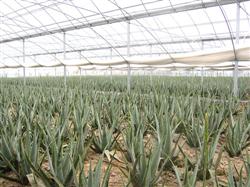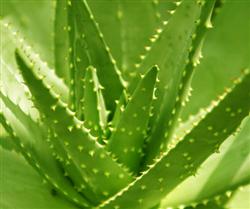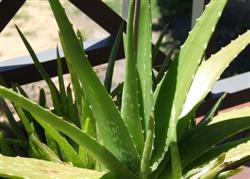Sharing: cultivation techniques of aloe in greenhouse

Aloe, also known as oil onion, is a plant of the genus Aloe of Liliaceae, which is native to India. The edible varieties of aloe are Curacao, Muli, China and so on. The main varieties cultivated in the local greenhouse are Curacao, alias Barbados aloe and emerald leaf aloe. In this paper, the botanical characteristics and cultivation points of aloe are introduced as follows: 1 Botanical characteristics most of aloe roots are fibrous roots and a few are bulbous roots. Most of aloe are perennial herbs, stemless or short-stemmed, and many are shrubs or climbers. The leaves of herbaceous aloe are multi-basal, and the leaves of shrubs and trees are cauline, mostly alternate and spirally arranged, mostly rosette-shaped leaf discs. The leaves are pulpy and the mesophyll is thick. Some leaves have spines on the back or thorns on the leaves. Leaves entire, mostly wavy serrate, a few ciliate. Aloe flowers terminal, lateral, racemose, umbellate, paniculate, Terete or head, usually infinite inflorescences. The flowers are red, brown, pink, yellow, orange and milky white. The pericarp is mostly a capsule and less berry. Seed coat gray or black, seeds irregularly trigonous to flattened. Aloe vera likes warm and humid climatic conditions, is not cold-resistant, the room temperature in winter should not be lower than 5 ℃, and it should be dry during dormancy. Like well-drained, fertile sandy loam. Lax requirements on the soil, tolerance to drought and salinity, no need for flood and fertilizer management. But like the sun, can not bear the shade, in the shade environment, do not blossom. 2 main points of aloe cultivation in greenhouse 2.1 soil preparation and fertilization generally choose land with high topography, low groundwater level, smooth drainage, loose soil, breathable and fertile land. Soil preparation and application of organic fertilizer, rotten organic fertilizer 2000~3000kg plus leafy vegetable compound fertilizer 100kg per mu. The width of the border should be considered to be able to build a greenhouse and cover the sunshade net. Generally, the width of the border is 0.5m in one row and 0.6m to 0.8m in double row. 2.2 Propagation method 2.2.1 seed sowing method Seeds are sown in spring and seedlings need to be raised on a sand plate before transplanting. 2.2.2 in the early spring, the new tillers around the mother plant were cut off from the underground stem of the mother plant and cultivated as seed plants. However, this method has a small number of tillers and less reproduction. 2.2.3 Cuttage is usually propagated by cuttings. The method is to cut the small lateral branches between the base of the main stem and leaf axils between spring and summer for cutting. Cut the new buds of 10~15cm, cut them from the base with a knife and place them in the shade for 1 day. After the cut is slightly dry, it is inserted into the culture soil. It can not be watered until 3 cm deep for 1 week, and it can take root in about 20 ~ 30 days. The trunk can also be cut off. Spring is the best time for cuttings to survive the winter safely. Do not water more in winter to prevent rotting roots. It is usually planted in the second spring. 2.3 the seedlings managed in the field should be irrigated after splitting, but they should not be too wet. Avoid noon irrigation, irrigation should be appropriate, if there is wet soil under the topsoil 2cm, you can not irrigate. When it is dry in summer, irrigate once every 1-2 days and human feces and urine once every 3-4 weeks to remove weeds in the shed. Strong direct sunlight should be avoided in summer, and the greenhouse should be covered with a sunshade net. It should be frostproof in winter, and the greenhouse should be heated when the external temperature is lower than 5 ℃, and the greenhouse should be ventilated when the temperature is high at noon. According to the author's investigation, the main diseases of aloe in local greenhouse are anthracnose and Botrytis cinerea, which can be sprayed with 1000 times of acetic acid solution. The main pests are shell insects and whiteflies, which can be sprayed with 1000 times of omethoate EC. (3) after the mature plant, the leaves can be harvested in stages and batches from bottom to top. The parts that can be harvested are tiller buds, leaves, flowers, scape and roots. Harvesting tiller buds can be used for reproduction. Aloe vera used for harvesting leaves must be more than 3 years old, each plant must have more than 20 leaves, most leaves must have 500g weight, 3 leaves can be harvested every time, 3 leaves can be harvested 4 times a year, and the mother plant must have more than 12 leaves and cannot be overharvested. The part of the harvest mouth must be from the base to the base of the sheath. The annual yield of fresh leaves per mu of adult plant can be 10 ~ 12000 kg. Click to get more aloe planting techniques click to get more flower planting techniques
- Prev

How to grow aloe in family potted plants?
Aloe is a very popular plant for women, not only because of its lovely shape and leaves, but also for its edible, medicinal and cosmetic effects. Family small potted aloe can also be placed on the desk and desk, with ornamental value. Potted aloe should choose mud basin with good air permeability. If you choose a new basin, you should use water.
- Next

How to maintain aloe in summer and autumn
Summer and autumn is an important period for the formation of aloe yield. Field management should focus on the "five prevention", that is, prevention of rigid seedlings, waterlogging, lodging, grass damage and diseases, and conscientiously do a good job in the following work: 1, the combination of work and fertilizer to promote the transformation and upgrading of seedling conditions. Aloe requires a large amount of fertilizer and is well ventilated in sandy soil.
Related
- Fuxing push coffee new agricultural production and marketing class: lack of small-scale processing plants
- Jujube rice field leisure farm deep ploughing Yilan for five years to create a space for organic food and play
- Nongyu Farm-A trial of organic papaya for brave women with advanced technology
- Four points for attention in the prevention and control of diseases and insect pests of edible fungi
- How to add nutrient solution to Edible Fungi
- Is there any good way to control edible fungus mites?
- Open Inoculation Technology of Edible Fungi
- Is there any clever way to use fertilizer for edible fungus in winter?
- What agents are used to kill the pathogens of edible fungi in the mushroom shed?
- Rapid drying of Edible Fungi

